Child Maintenance Service statistics: data to March 2022 (experimental)
Updated 28 July 2022
Applies to England, Scotland and Wales
The latest release of these statistics can be found in the collection of Child Maintenance Service statistics.
This release of statistics is on the Child Maintenance Service for Great Britain between January 2015 and March 2022. The release includes minor revisions to previously published statistics.
The next release is planned for 27 September 2022.
1. Introduction
The Child Maintenance Service (CMS) was introduced in December 2012 as part of the Government’s Child Maintenance reforms. It replaced the Child Support Agency (CSA) and is for separated parents who cannot arrange child maintenance between themselves. The CMS offers two levels of service:
- “Direct Pay” is where the CMS calculates the amount of maintenance to be paid, and parents arrange payments between themselves
- “Collect & Pay” is used when parents cannot arrange payments between themselves, or if the Paying Parent does not keep up with payments. The CMS will collect and manage payments between the parents
The CMS has a range of enforcement actions it can use if the Paying Parent refuses to pay.
2. Main stories
Children covered by Child Maintenance Service arrangements, March 2020 to March 2022

Source: Child Maintenance Service Children data, available on Stat-Xplore
There are 820,000 children covered by CMS arrangements:
- 513,800 children covered through Direct Pay arrangements
- 292,400 children covered through the Collect & Pay Service
- 13,800 children not yet assigned to a service
The number of children covered by CMS arrangements increased by 17,000 between December 2021 and March 2022.
Compliance rate of Paying Parents on the Collect & Pay service, quarters ending March 2021 to March 2022
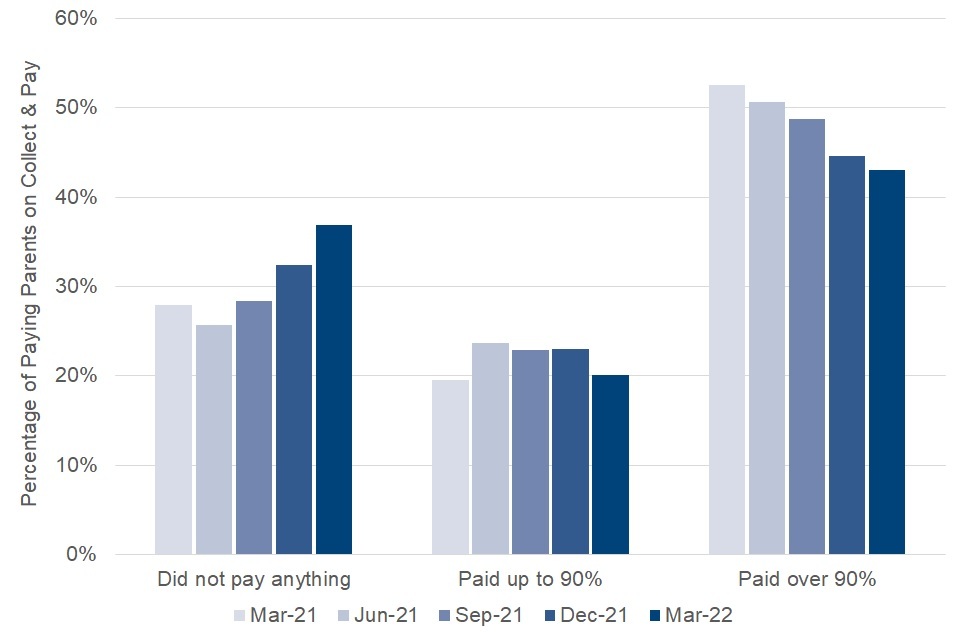
In the quarter ending March 2022, of 164,500 Paying Parents due to pay via the Collect & Pay service:
- 60,700 (37%) paid no maintenance
- 103,700 (63%) paid some maintenance, of which:
- 33,000 (20%) paid up to 90% of the maintenance due for the quarter (further breakdowns of this group are available on Stat-Xplore)
- 70,700 (43%) paid over 90% of the maintenance due for the quarter
The percentage of parents paying something towards their maintenance has fallen by 5 percentage points, to 63%, since the last quarter.
There has been a 10 percentage points decrease in the percentage of parents paying over 90% of their maintenance due for the quarter, since the quarter ending March 2021, falling steadily from 53% to 43%.
3. What you need to know
Child maintenance is financial support, towards a child’s everyday living costs, that a parent without the main day-to-day care of the child provides to the other parent.
Separated parents can arrange child maintenance themselves. This is called a ‘family-based arrangement’ and is a private way to sort out child maintenance. Parents arrange everything themselves and no-one else has to be involved.
The CMS replaced the Child Support Agency (CSA). It is for parents who cannot agree to a family-based arrangement.
Parents wishing to use the CMS must first use the Get Help Arranging Child Maintenance) service. This is a free service that provides impartial information and support to help separated parents make decisions about their child maintenance arrangements.
Definitions
Receiving Parent
The Receiving Parent has the main day-to-day care of the children and receives the child maintenance.
Paying Parent
The Paying Parent does not have the main day-to-day care of the children and pays child maintenance.
Children covered
Children covered is the number of children for whom the Paying Parent has a child maintenance arrangement.
Compliance
This measures how much maintenance has been successfully collected from the Paying Parent compared to the amount of new maintenance arranged via the Collect & Pay service in that three-month period. Note that, if a parent is trying to settle arrears that have previously accumulated, they would need to pay more than the amount of new maintenance arranged during the quarter.
See the Background Information document for more details.
4. Applications to the Child Maintenance Service
Parents who want to apply to the CMS must pay a £20 application fee. Parents do not have to pay this if they:
- have been a victim of domestic abuse
- declare their child has been the victim of abuse
- are under 19 years of age
Some applications to the CMS are from parents who previously had an arrangement with the Child Support Agency. All Child Support Agency cases with an ongoing liability were closed by December 2018. Parents were then encouraged to make a new family-based arrangement or an arrangement through the CMS. The CMS may still receive applications from parents who previously used the CSA, as they may have had a family-based arrangement in the interim.
Applications to the Child Maintenance Service, quarters ending March 2020 to March 2022
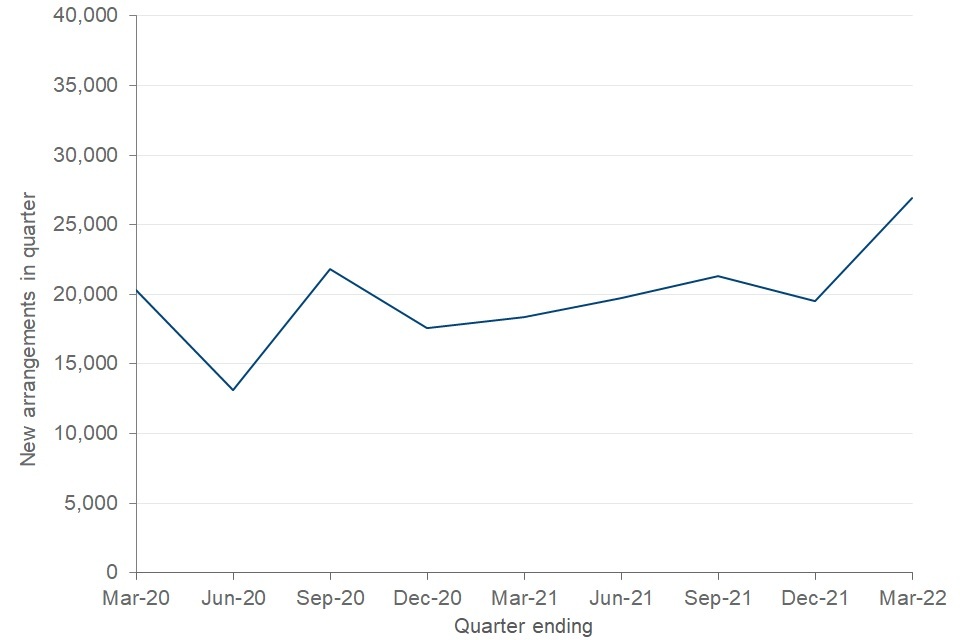
Source: Child Maintenance Service statistics data to March 2022, National Tables, table 3
In the quarter ending March 2022, there were 26,900 new applications to the CMS. 60% were exempt from paying the £20 application fee. This was mainly due to applicants who had previously experienced domestic abuse.
At the end of March 2022, the CMS was managing 588,700 arrangements for 544,600 Paying Parents. There has been an 7% increase to the number of arrangements since the end of March 2021.
See tables 1-3 of the national tables for more information on applications.
See Stat-Xplore for more information on arrangements and paying parents.
5. Composition of cases on the Child Maintenance Service
When a parent makes an application to the CMS, they will be told how much child maintenance should be paid.
Some parents will then arrange the payments between themselves: this service is known as Direct Pay. The CMS simply provides the calculation and no further use of the service is required. Direct Pay can be chosen by either parent with the other’s agreement. Neither parent pays collection fees under Direct Pay.
Parents are issued a text message 3 months after they set up a Direct Pay arrangement, and at each annual review, to check that the arrangement is still meeting their requirements.
If parents cannot arrange payments between themselves, or if the Paying Parent does not keep up with the payments, the Receiving Parent can ask the CMS to switch the case to the Collect & Pay service.
Under the Collect & Pay service, the CMS calculates the amount of maintenance due (including the recovery of unpaid maintenance that has built up under the Direct Pay service), collects maintenance from the Paying Parent, and pays it to the Receiving Parent.
There are ongoing collection charges for use of the Collect & Pay service, payable by both:
- the Paying Parent (20% charged on top of the maintenance amount)
- the Receiving Parent (4% taken out of the maintenance amount)
Non-compliance under the Collect & Pay service can lead to the use of enforcement powers.
Flow of arrangements on the Child Maintenance Service, quarter ending March 2022
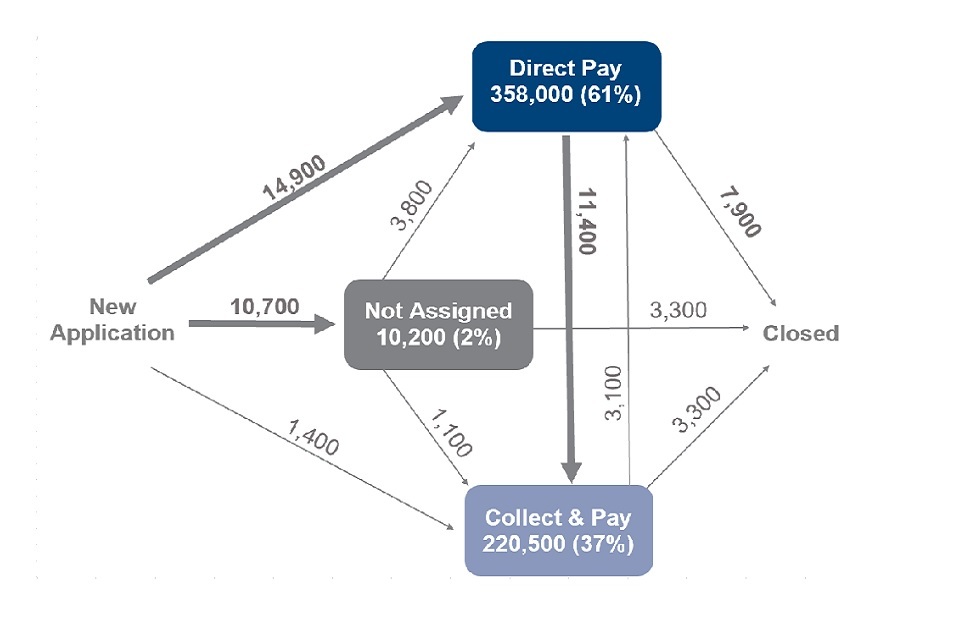
Source: Child Maintenance Service statistics data to March 2022, National Tables, table 4
Data on the flow of arrangements around the CMS in the quarter ending March 2022 shows:
- most new applicants start on Direct Pay: 14,900 new applicants joined Direct Pay during the quarter
- 61% of all CMS arrangements use Direct Pay, with 37% using Collect & Pay
- more parents moved from Direct Pay to Collect & Pay than the other way around: 11,400 parents switched to Collect & Pay during the quarter
- the number of arrangements overall increased by 12,700 during the quarter
- the number of arrangements not yet assigned to a service has increased from 7,700 to 10,200
See table 4 of the national tables for more information.
See Stat-Xplore for more information on arrangements.
6. Children covered by the Child Maintenance Service
Children covered by the Child Maintenance Service, quarters ending March 2020 to March 2022
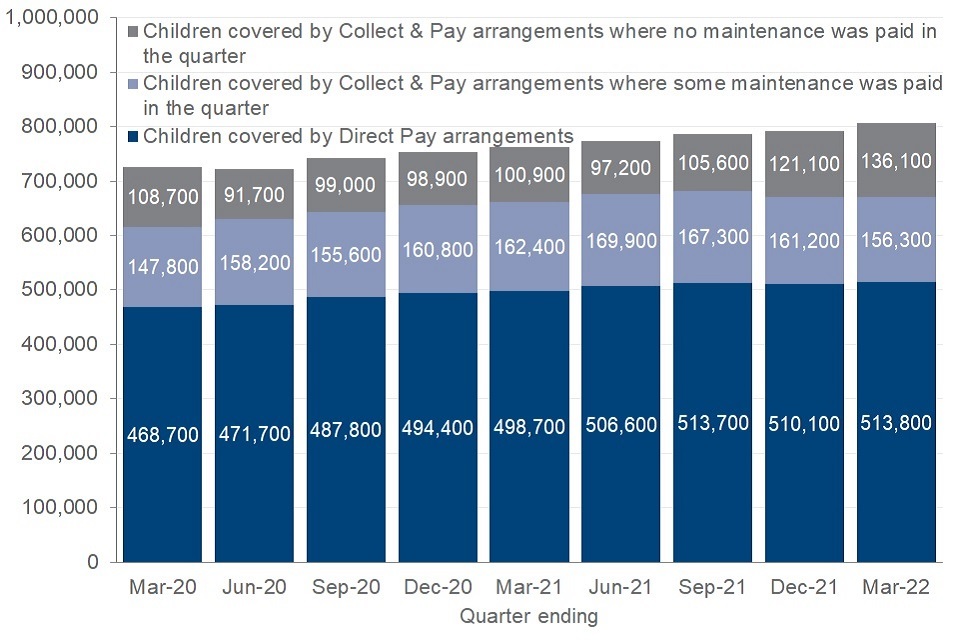
Source: Child Maintenance Service Children data, available on Stat-Xplore.
At the end of March 2022:
- 513,800 children were covered by 358,000 Direct Pay arrangements
- 292,400 children were covered by 220,500 Collect & Pay arrangements
- 156,300 of these children were covered by 111,100 Collect & Pay arrangements where the Paying Parent paid some maintenance during the quarter
The number of children covered by CMS arrangements has increased steadily over the last 2 years.
See Stat-Xplore for more information on children.
7. Paying Parents and the Collect and Pay service
This section defines compliance as any money paid towards Child Maintenance due on a Paying Parent’s case. It does include analysis into the reasons why a Paying Parent may not pay.
This includes Paying Parents transferred from the Direct Pay service because they have not kept up with payments.
Compliance rate of Paying Parents on the Collect & Pay Service, quarters ending March 2020 to March 2022
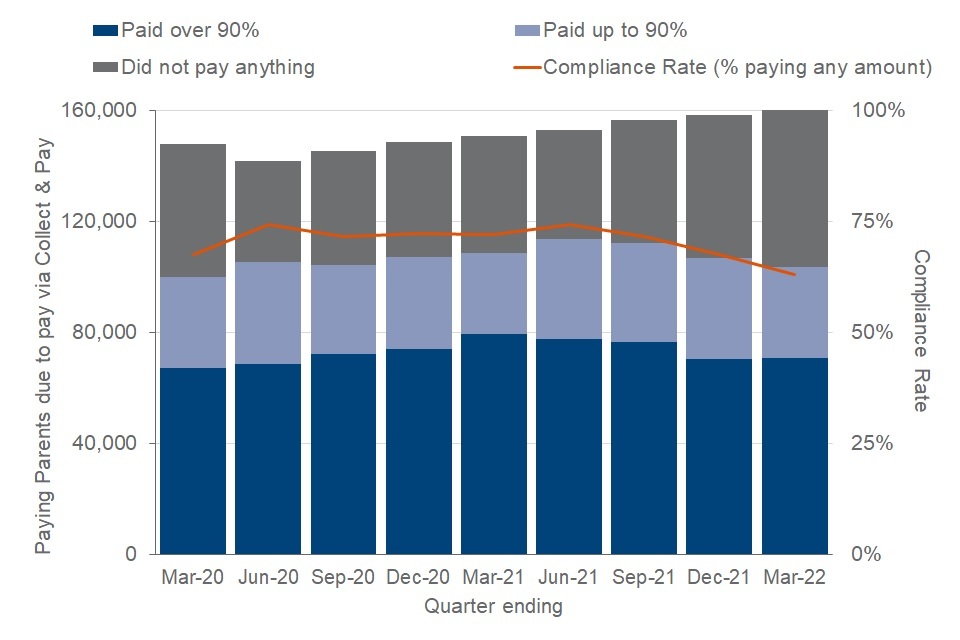
Source: Child Maintenance Service Paying Parents data, available on Stat-Xplore.
In the quarter ending March 2022, of 164,500 Paying Parents due to pay via the Collect & Pay service:
- 60,700 (37%) paid no maintenance
- 103,700 (63%) paid some maintenance, of which:
- 33,000 (20%) paid up to 90% of the maintenance due for the quarter (further breakdowns of this group are available on Stat-Xplore)
- 70,700 (43%) paid over 90% of the maintenance due for the quarter
There has been a 10 percentage points decrease in the percentage of parents paying over 90% of their maintenance due for the quarter, since the quarter ending March 2021, falling steadily from 53% to 43%.
Parents paying over 90% are grouped together because even if a Paying Parent is fully complying with an arrangement, their compliance rate may not be exactly 100%. This is due to differences between how liability accumulates on the CMS ‘liability schedule’ (used to calculate the amount due) and how collections are scheduled in practice. This group also includes Paying Parents who have paid more than 100% of their liability for the quarter, to pay off arrears that they have previously accumulated.
The percentage of parents paying something towards their maintenance has fallen by 5 percentage points, to 63%, since the last quarter.
Since June 2021, there has been a persistent decrease each quarter from 74% to 63%, in those paying anything towards their maintenance. This drop of 11 percentage points over the last 3 quarters should be seen in the context of:
- a 16 percentage point decrease (from 82% to 66%) in the proportion of Paying Parents paying via Deduction from Benefits who paid anything towards their maintenance due, from June 2021 to March 2022. This group now accounts for 34% of all Paying Parents on Collect & Pay in March 2022 compared with 38% in June 2021
- an 8 percentage point decrease (from 47% to 39%) in the proportion of Paying Parents paying via Standing Order (Voluntary and Default) who paid anything towards their maintenance due, from June 2021 to March 2022. This group now accounts for 31% of all Paying Parents on Collect & Pay in March 2022 compared with 25% in June 2021
- a range of contributing factors including, but not exclusive to:
- Paying Parents who were temporarily on Universal Credit (UC) during the COVID-19 pandemic moving off benefits
- a change to government policy in October 2021, saw the removal of the temporary £20 uplift for UC claimants. This led to an increase in the number of UC claimants, who were due to pay via Deduction from Benefit, not having enough benefit remaining within the UC deduction cap to allow a Child Maintenance deduction to be taken
The COVID-19 pandemic had two main effects on the Collect & Pay compliance rate:
- during the early stages of the COVID-19 pandemic, child maintenance deductions from Universal Credit (UC) were paused for one month (10th April to 9th May 2020). During this time, the Government paid all child maintenance liabilities for parents who were paying via deductions from UC. This raised the compliance rate for the quarter ending June 2020 only
- individuals paying via Deduction from Benefits are more likely to contribute some maintenance, as deductions are made automatically. December 2019 was the last quarter entirely unaffected by the Covid-19 pandemic. The proportion of parents paying via Deduction from Benefits increased following the Covid-19 pandemic, which saw more movement of people onto benefits. Deduction from Benefit cases accounted for 25% of all Paying Parents due to pay via Collect & Pay in the quarter ending December 2019 and rose to 41% by the quarter ending December 2020
See Stat-Xplore for more information on Paying Parents.
8. Paying Parents characteristics
In the quarter ending March 2022, of the 544,600 Paying Parents:
- 93% were recorded as male
- nearly three-quarters (73%) were between the ages of 30 and 50
- 56% had 1 qualifying child
- of those who had 2 or more qualifying children, 84% had 1 arrangement and 16% had 2 or more arrangements
Counts of qualifying children include all children who are associated with an open arrangement and are below 20 years of age.
See Stat-Xplore for more information on Paying Parents.
9. Child Maintenance due and paid
The CMS monitors payments made through the Collect & Pay service and can take enforcement action where necessary.
Parents on Direct Pay with unpaid maintenance owed will first have to transfer to Collect & Pay before the CMS can take any action. This means the Collect & Pay service consists of a subset of Paying Parents who are less likely to pay.
Child Maintenance due and paid each quarter, quarters ending March 2021 to March 2022
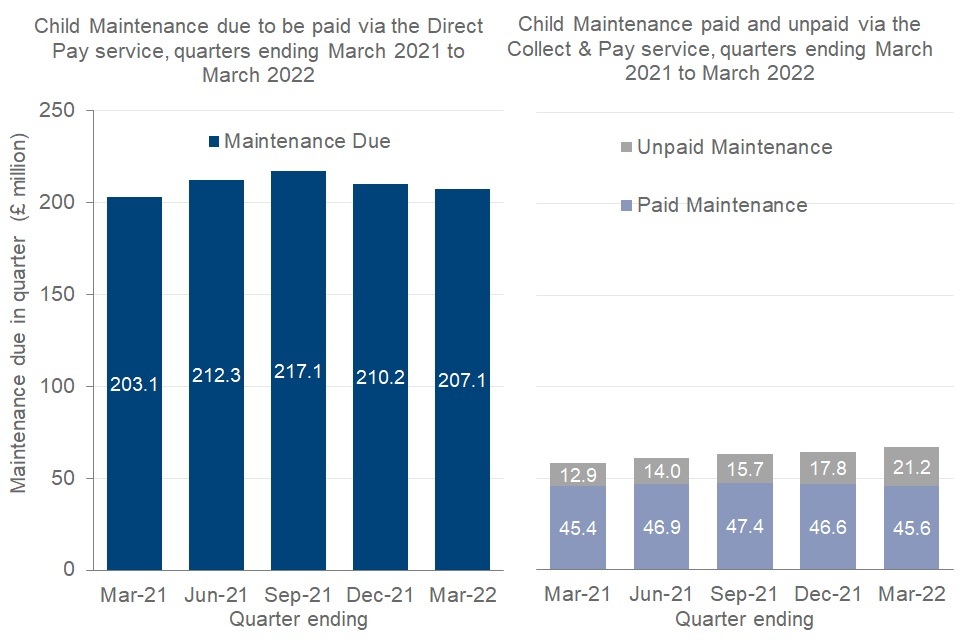
Source: Child Maintenance Service statistics data to March 2022, National Tables, table 5
During the quarter ending March 2022, £273.9 million Child Maintenance was due to be paid either via the Direct Pay service or the Collect & Pay service.
£207.1 million was arranged through the Direct Pay service.
We do not measure the compliance of Paying Parents on the Direct Pay service.
£66.8 million was arranged through the Collect & Pay service:
- £45.6 million was paid
- £21.2 million was unpaid maintenance due to be paid through the Collect & Pay service including any transferred from Direct Pay
Since 2012, when the CMS began, £474.2 million in unpaid maintenance has accumulated. This amounts to 8% of all maintenance due to be paid since the start of the service.
See tables 5 and 6 of the national tables for more information.
10. Enforcement
When a payment is missed, the CMS contacts the Paying Parent to arrange a recovery of what is owed and make clear the actions that may be pursued in the absence of a payment.
For parents on Collect & Pay, enforcement is automatically pursued on their behalf.
For parents on Direct Pay, the arrangement must be switched to the Collect & Pay service before any enforcement action can commence.
The CMS can enforce the collection of child maintenance in four major ways:
-
deduction from earnings order or request – money is recovered from the Paying Parent’s earnings via their employer, who will be instructed on the amount to deduct.
-
deduction from benefit – money is recovered from the Paying Parent’s benefits.
-
deduction order – money is deducted directly from the Paying Parent’s bank or building society account.
-
courts – a Paying Parent can be taken to court over unpaid maintenance.
The Child Maintenance Service can enforce the regular collection of ongoing maintenance through Deduction from Earnings Orders and Requests, or through Deduction from Benefits. The Paying Parent may also opt to use these methods of payment voluntarily.
Methods of Payment used on the Collect & Pay Service, quarters ending March 2020 to March 2022
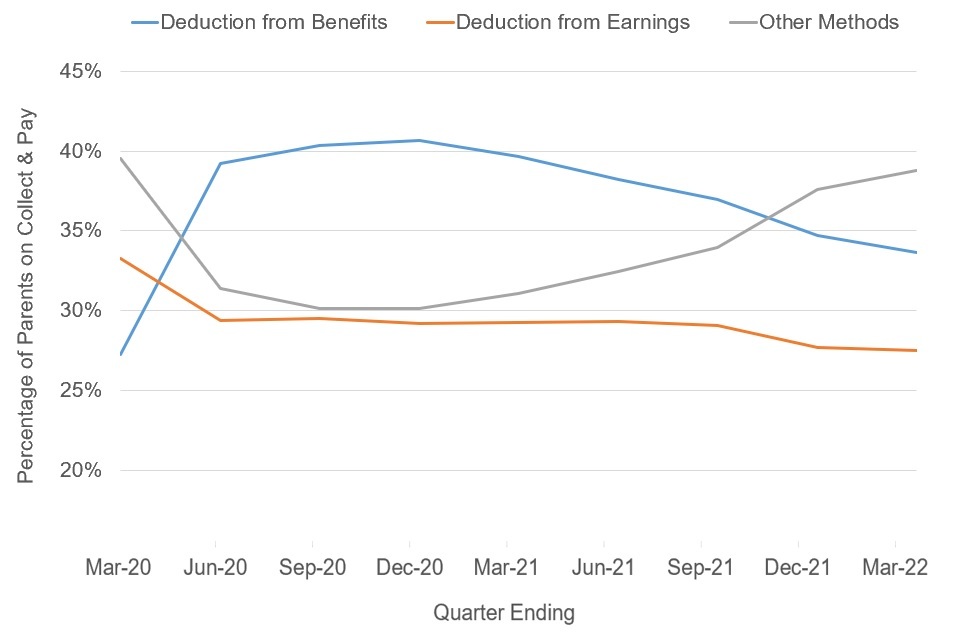
Source: Child Maintenance Service Paying Parents data, available on Stat-Xplore.
In the quarter ending March 2022, of 164,500 Paying Parents due to pay via the Collect & Pay service:
- 45,300 (28%) had a Deduction from Earnings Order or Request in place
- 55,400 (34%) were due to pay via Deduction from Benefits
- 63,800 (39%) were due to pay via other methods of payment
The “other methods of payment” were predominantly default standing orders. See Stat-Xplore for more information on payment methods.
December 2019 was the last quarter entirely unaffected by the COVID-19 pandemic. The proportion of parents paying via Deduction from Benefits increased following the COVID-19 pandemic, which saw more movement of people onto benefits. Deduction from Benefit cases accounted for 25% of all Paying Parents due to pay via Collect & Pay in the quarter ending December 2019 and rose to 41% by the quarter ending December 2020. From the year to March 2022, there has been a steady decrease in this measure to 34%.
The CMS may pursue unpaid maintenance through the courts. The courts can grant liability orders, which allow further action to be taken, such as referral to enforcement agents, who can seize goods and sell them to cover any unpaid maintenance and costs. Where the Paying Parent is a homeowner, courts may grant a charging order against the property. This prevents any sale without repayment of unpaid maintenance. Ultimately, the court may grant an order for sale which forces the sale of the property.
Deduction Orders and Civil Enforcement Actions in process, quarters ending March 2020 and March 2022
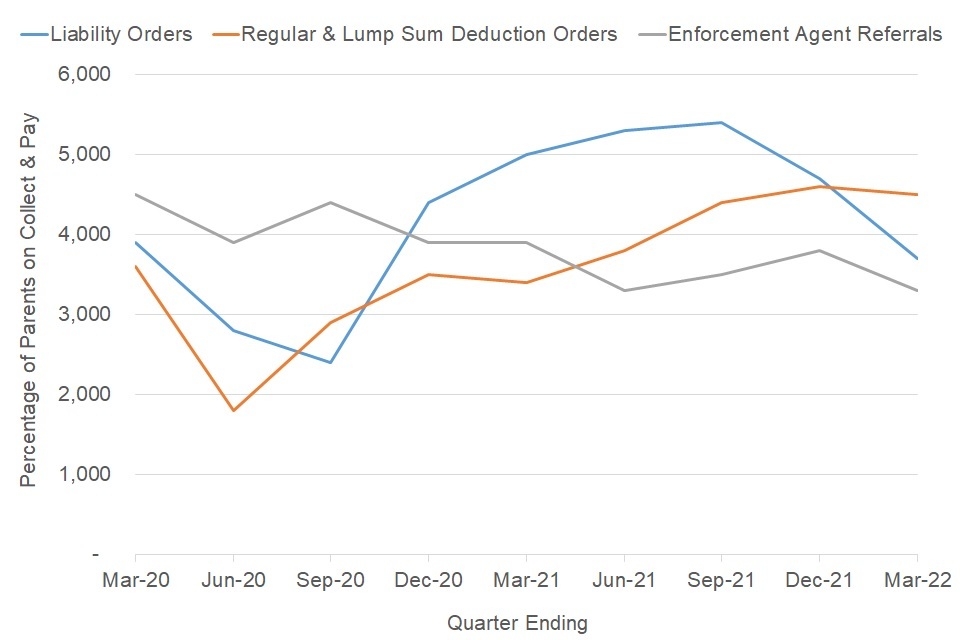
Source: Child Maintenance Service statistics data to March 2022, National Tables, table 7.1
At the end of March 2022:
- 3,700 Liability Orders were in process
- 4,500 Regular or Lump Sum Deduction Orders were in process
- 3,300 Enforcement Agent Referrals were in process
If the above methods are unsuccessful, the CMS Service may apply for the courts to:
- disqualify the parent from holding or obtaining a driving licence
- disqualify the parent from holding or obtaining a passport
- send the parent to prison
In the past year to March 2022, the Child Maintenance Service has collected over £2 million from Paying Parents with a sanctions action in process.
A Paying Parent is described as a having a sanctions action in process when a Service Request is raised to formally consider applying sanctions to a Paying Parent. Not all such cases will result in an application being made to courts - the volume and breakdown of cases reaching court is outlined in Table 7.2 of the national tables.
Sanctions are only used when every other method of recovering unpaid child maintenance has been tried. The Child Maintenance Service only pursues these sanctions when they believe the Paying Parent can pay but are refusing to do so.
See tables 7.1 and 7.2 of the national tables for more information.
Enforcement during the COVID-19 pandemic
Taking substantial enforcement action relies on third parties, including Her Majesty’s courts, bailiffs and the banks. A number of third parties were not in a position to fully support enforcement activity during the early stages of the pandemic. Liability Orders, which are the gateway measure to legal enforcement activity, required the most court involvement and were the most difficult measure to restart while social distancing requirements remained in place. The CMS worked with HM Courts and Tribunals Service to establish alternatives to face to face court hearings by setting up video / phone hearings where outcomes were received digitally. Presently partnership work has returned to normal levels.
11. About these statistics
Comparisons
Comparisons between these statistics on the CMS and statistics previously published on the Child Support Agency or CSA Tables 8.1 (Collections and write-off on case groups with CSA arrears) and 8.2 (Methods of debt collection for case groups with CSA arrears), which are now published alongside the CMS statistics, should not be made as the 2 services have different aims and cover different groups.
The government’s changes to the child maintenance system in 2012 were designed to encourage parents to work together to provide for their children. Get Help Arranging Child Maintenance was created to support parents to set up collaborative, family-based arrangements. The CMS was intended for those parents who cannot make family-based arrangements.
Rounding
Figures contained within this publication are rounded to the nearest hundred, percent, or £100,000. This means unrounded figures from the underlying data available on Stat-Xplore may not sum exactly to the rounded totals used in this release. Percentages are calculated prior to rounding.
These statistics have been developed using guidelines set out by the UK Statistics Authority.
Changes made to this publication
No major changes made to the publication this quarter.
Where to find out more
Read the Background Information document for more details on the CMS statistics.
Read previous releases of these statistics.
Read information and statistics on family-based arrangements.
Related Statistics: Child Support Agency statistics and Estimates of the Separated Family Population Statistics.
12. Future Development and Your Feedback
Planned Changes
We are hoping to move more of our regular statistics to the Stat-Xplore platform in the near future.
Feedback and queries
If you have any views on the above changes, queries or feedback on any aspect of our statistics please email cm.analysis.research@dwp.gov.uk
Authors: Amy Grant and Ebun Edwin
Lead statistician: Juwaria Rahman
ISBN: 978-1-78659-437-2
